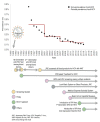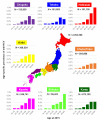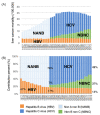Epidemiology of viral hepatitis C: Road to elimination in Japan
- PMID: 34782867
- PMCID: PMC8562096
- DOI: 10.35772/ghm.2021.01069
Epidemiology of viral hepatitis C: Road to elimination in Japan
Abstract
Although HCV infection was the main cause of HCC in Japan contributing 70% over two decades after its first cloning in 1989, it was markedly decreased to 49% in 2013 and expected to decrease continuously. Based on blood donor national database, the new incident cases were 0.4/100,000 person-years, the prevalence was 0.13% and the total number was 890,902-1,302,179 in 2015. Establishment of blood donor screening with anti-HCV measurement and nucleic acid test introduced by Japanese Red Cross as pioneer, high-level medical and surgical care, and the government's policy under the Basic Act on Hepatitis Control have changed its epidemiology and outbreak trend and also enforced the disruption of potential transmission cascades. HCV prevalence among the younger generation was extremely low in all regions, and the predominant age for HCC has shifted to over 60 years old population. Considering such changes, HCV induced HCC occurrence is supposed to be ultimately suppressed in the near future. However, taking into account society changes, regulating intravenous drugs users and monitoring high-risk groups such as tattoos, and men who have sex with men are indeed required in Japan. Understanding the epidemiological changes in HCV is important in assigning, modifying, and designating effective response systems. Selective or national action plans, strategic approaches, and cooperation between government sectors have a positive impact on HCV prevention and control. A dramatic decrease in total number of HCV carriers, increase in number of people treated with highly effective DAA, and subsequent high SVR indicates Japan might achieve WHO's target of HCV elimination by 2030.
Keywords: Japan; countermeasure; disease burden; elimination.
2021, National Center for Global Health and Medicine.
Conflict of interest statement
The authors have no conflicts of interest to disclose.
Figures






Similar articles
-
Liver cancer and its prevention.Asian Pac J Cancer Prev. 2005 Jul-Sep;6(3):244-50. Asian Pac J Cancer Prev. 2005. PMID: 16235981 Review.
-
National prevention of hepatocellular carcinoma in Japan based on epidemiology of hepatitis C virus infection in the general population.Intervirology. 2006;49(1-2):7-17. doi: 10.1159/000087257. Intervirology. 2006. PMID: 16166783
-
Hepatocellular carcinoma associated with hepatitis C virus infection in Japan: projection to other countries in the foreseeable future.Oncology. 2002;62 Suppl 1:8-17. doi: 10.1159/000048270. Oncology. 2002. PMID: 11868791
-
Countermeasures against viral hepatitis B and C in Japan: An epidemiological point of view.Hepatol Res. 2019 Sep;49(9):990-1002. doi: 10.1111/hepr.13417. Epub 2019 Aug 22. Hepatol Res. 2019. PMID: 31364248 Free PMC article. Review.
-
Role of direct and indirect social and spatial ties in the diffusion of HIV and HCV among people who inject drugs: a cross-sectional community-based network analysis in New Delhi, India.Elife. 2021 Aug 3;10:e69174. doi: 10.7554/eLife.69174. Elife. 2021. PMID: 34342266 Free PMC article.
Cited by
-
Response to antiviral therapy for chronic hepatitis C and risk of hepatocellular carcinoma occurrence in Japan: a systematic review and meta-analysis of observational studies.Sci Rep. 2023 Mar 1;13(1):3445. doi: 10.1038/s41598-023-30467-5. Sci Rep. 2023. PMID: 36859564 Free PMC article.
-
Core indicators related to the elimination of hepatitis B and C virus infection in South Korea: A nationwide study.Clin Mol Hepatol. 2023 Jul;29(3):779-793. doi: 10.3350/cmh.2023.0110. Epub 2023 May 15. Clin Mol Hepatol. 2023. PMID: 37188331 Free PMC article.
-
Liver disease trends in the Asia-Pacific region for the next 50 years.Clin Mol Hepatol. 2025 Jul;31(3):671-684. doi: 10.3350/cmh.2025.0043. Epub 2025 Mar 4. Clin Mol Hepatol. 2025. PMID: 40037692 Free PMC article. Review.
-
Prevalence of hepatitis B and C, and their linkage to care among drug abusers attending psychiatric hospital in Hiroshima, Japan.GHM Open. 2024 Jul 31;4(1):1-10. doi: 10.35772/ghmo.2023.01017. GHM Open. 2024. PMID: 40144738 Free PMC article.
-
Challenges in advanced heart failure care in Japan: Bridging the gap in durable mechanical circulatory support utilization and heart transplantation.JHLT Open. 2024 Dec 31;7:100204. doi: 10.1016/j.jhlto.2024.100204. eCollection 2025 Feb. JHLT Open. 2024. PMID: 40144849 Free PMC article. Review.
References
-
- Feinstone SM, Kapikian AZ, Purcell RH, Alter HJ, Holland PV. Transfusion-associated hepatitis not due to viral hepatitis type A or B. N Engl J Med. 1975; 292:767-770. - PubMed
-
- Bukh J. The history of hepatitis C virus (HCV): Basic research reveals unique features in phylogeny, evolution and the viral life cycle with new perspectives for epidemic control. J Hepatol. 2016; 65:S2-S21. - PubMed
-
- World Health Organization (WHO). HCV Fact Sheet. 2020. https://www.who.int/news-room/fact-sheets/detail/hepatitis-c (accessed May 22, 2021).
-
- Choo QL, Kuo G, Weiner AJ, Overby LR, Bradley DW, Houghton M. Isolation of a cDNA clone derived from a blood-borne non-A, non-B viral hepatitis genome. Science. 1989; 244:359-362. - PubMed
Publication types
LinkOut - more resources
Full Text Sources

